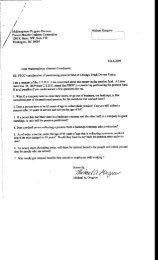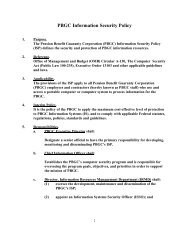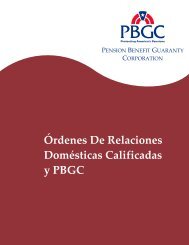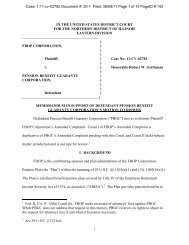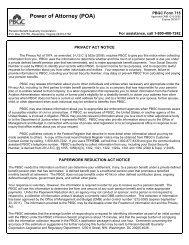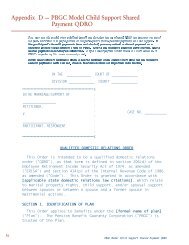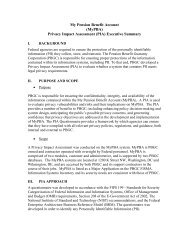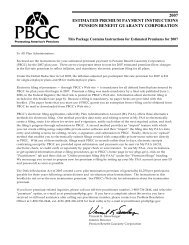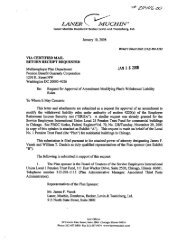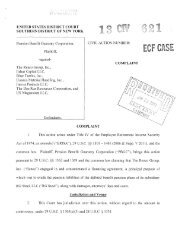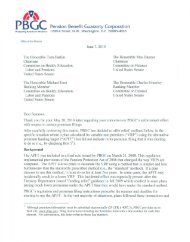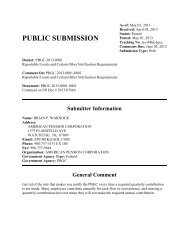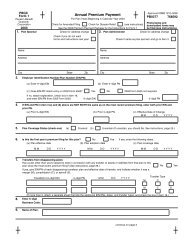(1) Partial Withdrawals. Contribution Decline. - Pension Benefit ...
(1) Partial Withdrawals. Contribution Decline. - Pension Benefit ...
(1) Partial Withdrawals. Contribution Decline. - Pension Benefit ...
Create successful ePaper yourself
Turn your PDF publications into a flip-book with our unique Google optimized e-Paper software.
<strong>Pension</strong> <strong>Benefit</strong> Guaranty Corporation<br />
93-2<br />
July 7, 1993<br />
REFERENCE:<br />
[*1] 4205(a)(1) <strong>Partial</strong> <strong>Withdrawals</strong>. <strong>Contribution</strong> <strong>Decline</strong>.<br />
>4205(b)(1)><br />
>4206(a)(2)(A)><br />
OPINION:<br />
I write in response to your letter requesting guidance on the calculation of partial withdrawal liability following a<br />
70-percent decline in contributions under Section 4206 of the Employee Retirement Income Security Act of 1974<br />
("ERISA"), as amended, 29 U.S.C. § 1386 (1992). Specifically, you request our opinion on what plan year's<br />
contribution base units make up the numerator of the fraction described at Section 4206(a)(2) of ERISA, 29 U.S.C. §<br />
1386(a)(2).<br />
Generally, a partial withdrawal occurs on the last day of a plan year in which an employer experiences a 70-percent<br />
contribution decline. ERISA § 4205(a)(1), 29 U.S.C. § 1385(a)(1). A 70-percent contribution decline occurs whenever<br />
an employer's contribution base units in each year of a "3-year testing period" do not exceed 30 percent of the employer's<br />
contribution base units in the "high base year." ERISA § 4205(b)(1)(A), 29 U.S.C. § 1385(b)(1)(A). For these<br />
purposes, the 3-year testing period includes the current plan year and the two immediately preceding plan years. ERISA<br />
§ 4205(b)(1)(B)(i), [*2] 29 U.S.C. § 1385(b)(1)(B)(i). The contribution base units in the high base year is an average<br />
of the two highest yearly contribution base unit amounts in the 5 plan years immediately preceding the 3-year testing<br />
period. ERISA § 4205(b)(1)(B)(ii), 29 U.S.C. § 1385(b)(1)(B)(ii).<br />
An employer's liability for a partial withdrawal is determined pursuant to Section 4206 of ERISA, 29 U.S.C. § 1386.<br />
In the case of a partial withdrawal occurring because of a 70-percent contribution decline, the first step is to calculate<br />
the amount of unfunded vested benefits allocable to the employer for a hypothetical complete withdrawal under Section<br />
4211 of ERISA, 29 U.S.C. § 1391, determined "as if the employer had withdrawn in a complete withdrawal . . . on the<br />
last day of the first plan year in the 3-year testing period." ERISA § 4206(a)(1)(B); 29 U.S.C. § 1386(a)(1)(B). This<br />
figure is then adjusted by multiplying it by 1 minus a fraction the numerator of which is the employer's contribution base<br />
units for the plan year following the plan year in which the partial withdrawal occurs, and the denominator of which is<br />
the average of the employer's contribution base units for the 5 plan years immediately [*3] preceding the 3-year testing<br />
period. ERISA § 4206(a)(2)(A) and (B); 29 U.S.C. § 1386(a)(2)(A) and (B).<br />
You ask whether the numerator of the fraction is the contribution base units for the plan year following the<br />
hypothetical complete withdrawal (i.e., the second plan year in the 3-year testing period), or the contribution base units<br />
for the plan year following the third plan year in the 3-year testing period. Under Sections 4205(b)(1) and 4206(a)(2)(A)<br />
of ERISA, 29 U.S.C. § § 1385(b)(1) and 1386(a)(2)(A), the answer is the latter.<br />
As stated above, a partial withdrawal is deemed to occur on the last day of a plan year in which the employer's<br />
contribution base units in each year of a 3-year testing period do not exceed 30 percent of the employer's contribution<br />
base units in the high base year. ERISA § 4205(b)(1)(A), 29 U.S.C. § 1385(b)(1)(A). The three year test period<br />
includes the current plan year and the two immediately preceding plan years. ERISA § 4205(b)(1)(B)(i), 29 U.S.C. §<br />
1385(b)(1)(B)(i). The "contribution base units for the plan year following the plan year in which the partial withdrawal<br />
occurs" referenced in Section 4206(a)(2)(A) of ERISA, 29 U.S.C. § 1386(a)(2)(A) [*4] (emphasis added), thus refers<br />
to the plan year following the last plan year in the 3-year testing period.<br />
Using your example of a partial withdrawal occurring in 1992, an employer's liability is calculated using the amount<br />
of unfunded vested benefits allocable to the employer under Section 4211 of ERISA, 29 U.S.C. § 1391, for a<br />
hypothetical complete withdrawal occurring in 1990, the first plan year in the 3-year test period. This amount is then<br />
multiplied by 1 minus a fraction the numerator of which is the employer's contribution base units for 1993, and the<br />
denominator of which is the employer's average contribution base units for the years 1985 through 1989.
I hope this has been of assistance to you. If you have any further questions, please contact D. Bruce Campbell of<br />
my staff at (202) 778-1918.<br />
Carol Connor Flowe, General Counsel



